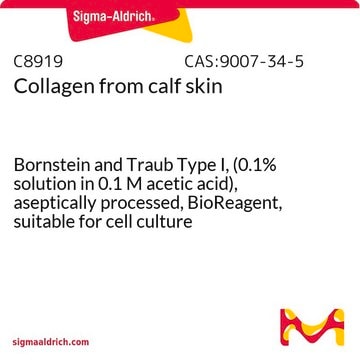일반 설명
All collagen molecules are composed of three polypeptide chains arranged in a triple helical conformation, with a primary structure that is mostly a repeating motif with glycine in every third position and proline or 4-hydroxyproline frequently preceding the glycine residue. Type I collagen differs from other collagens by its low lysine hydroxylation and low carbohydrate composition. Collagen type I is a component of skin, bone, tendon, and other fibrous connective tissues. It is a left handed helix with three polypeptide chains and contains repeating units of glycine, proline and hydroxyproline amino acids. It is a component of extracellular matrix and close to 28 types is present in bovine.
애플리케이션
Collagen from calf skin has been used:
- as a component of collagen gel matrix for culturing preantral follicles
- as a component of Roswell Park Memorial Institute, for culturing gilthead seabream kidney leukocytes and macrophages and acidophilic granulocytes
- to coat transwells prior to seeding of epithelial cell culture
This product is intended to produce thin layer coatings on tissue culture plates to facilitate attachment of anchorage-dependent cells, recommended for use at 6-10 μg/cm2. It is NOT intended for production of 3-D gels. Type I collagen is often used in cell culture as an attachment substratum with myoblasts, spinal ganglia, hepatocytes, embryonic lung, heart explants, fibroblasts, endothelial cells, and islet cells have all been cultured successfully on films or gels of type I collagen. Collagen type I may also be used in research of Idiopathic pulmonary fibrosis (IPF), studies on the effect of ER stress IPF on lung fibroblasts. Collagen in acidic solution can produce three dimensional scaffolding with use in bioengineering and cell culture applications.
생화학적/생리학적 작용
Collagen from calf skin is intended to produce thin layer coatings on tissue culture plates to facilitate attachment of anchorage-dependent cells, recommended for use at 6-10 μg/cm2. It is NOT intended for production of 3-D gels. Type I collagen is often used in cell culture as an attachment substratum with myoblasts, spinal ganglia, hepatocytes, embryonic lung, heart explants, fibroblasts, endothelial cells, and islet cells have all been cultured successfully on films or gels of type I collagen. Collagen type I may also be used in research of Idiopathic pulmonary fibrosis (IPF), studies on the effect of ER stress IPF on lung fibroblasts. Collagen in acidic solution can produce three dimensional scaffolding with use in bioengineering and cell culture applications. Mutations in collagen encoding proteins are implicated cattle diseases. Collagen type I on heat denaturation results in disruption of triple helix to a randomly coils. It has applications in food and cosmetics and is used as biomaterial in in tissue engineering.
성분
All collagen molecules are composed of three polypeptide chains arranged in a triple helical conformation, with a primary structure that is mostly a repeating motif with glycine in every third position and proline or 4-hydroxyproline frequently preceding the glycine residue. Type I collagen differs from other collagens by its low lysine hydroxylation and low carbohydrate composition.
제조 메모
This product was prepared by a modification of Gallop, P.M. and Seifter, S., Meth. Enzymol., VI, 635 (1963). It is soluble at 1 mg/mL in .1 M acetic acid and should be stirred at room temperature for 1-3 hours until dissolved.
기타 정보
Collagen is classified into a number of structurally and genetically distinct types. We use the nomenclature proposed by Bornstein and Traub. Do not confuse Sigma type designations with recognized collagen classification types.







